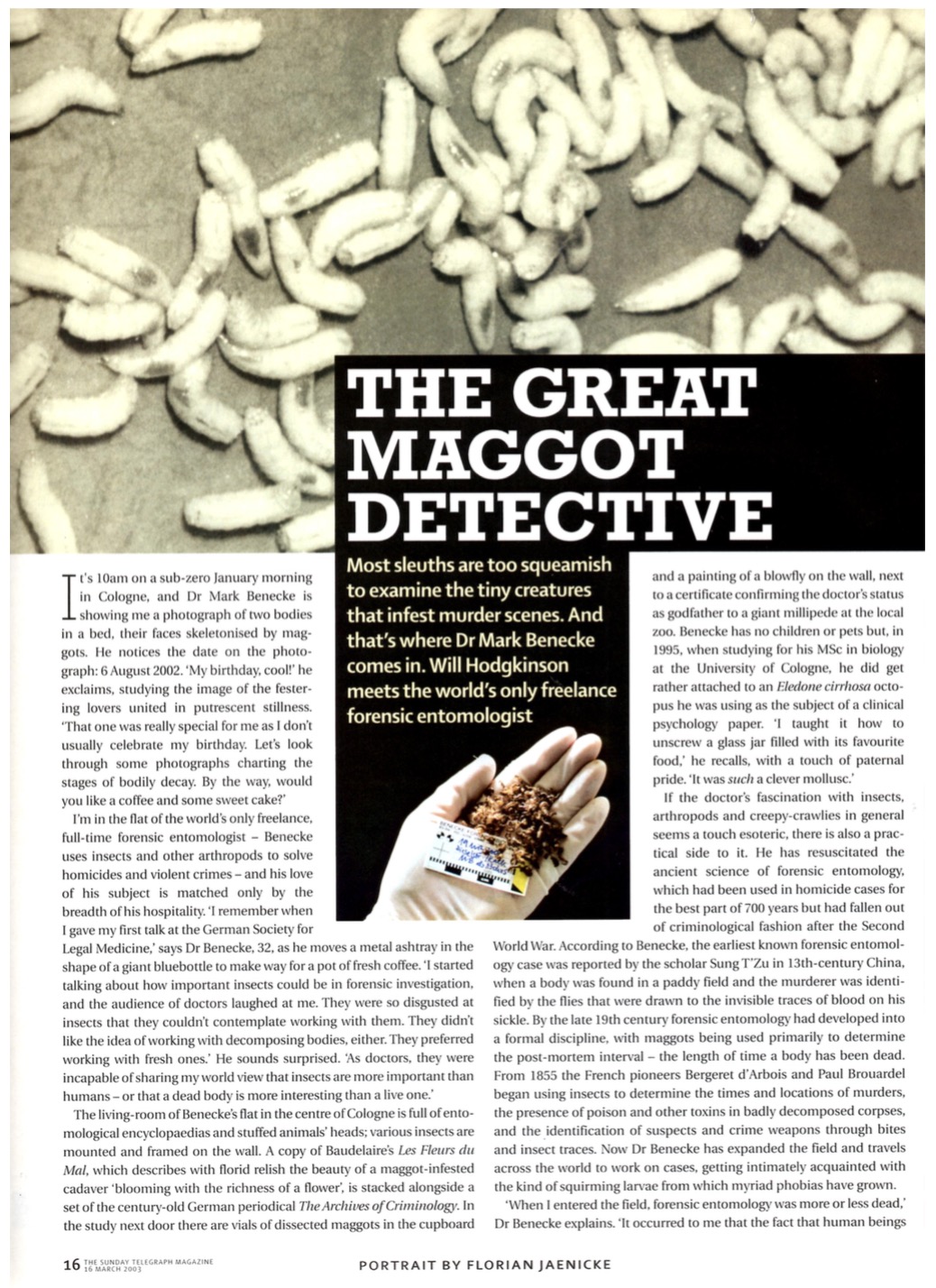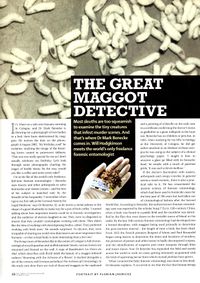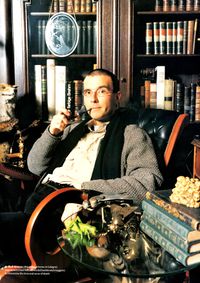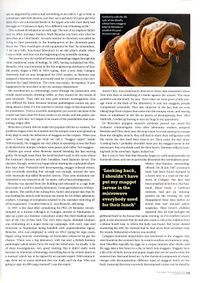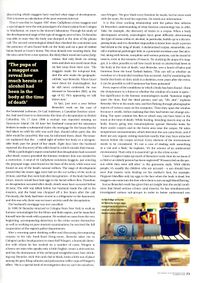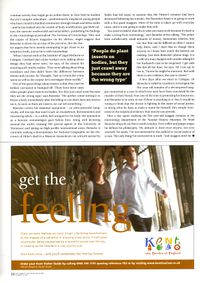2003-03-16 The Sunday Telegraph Magazine: The Great Maggot Detective/The Death Detective
Source: Sunday Telegraph Magazine (London), 16. March 2003, p.16-22
YOU Magazine, South Africa, 8. May 2003, p. 28-32
Maxim UK, August 2003, p. 53-59
The Great Maggot Detective/The Death Detective
[More articles from MB] [More about MB]
[Chinese version of this article: Detective of the Dead] CHINESE TEXT
[German-Chinese art exhibition: Body Reincarnated Flesh Berlin 2008] GERMAN TEXT
[MB on Chinese tattoo artist Dong Dong HERE and HERE] GERMAN TEXT
[MB in Bejiing] ENGLISH TEXT
[MB in Police Daily] CHINESE TEXT
[A brief survey of the history of forensic entomology] ENGLISH TEXT
[MB is the Detective of Decay] CHINESE TEXT
Text: Will Hodgkinson
Portrait photographs in Sunday Telegraph by Florian Jaenicke, electron microscopic maggot photograph by Eye of Science, all other photographs by Mark Benecke. Photos in Maxim UK article by different sources, including Martin Schoeller (Manhattan) and Zik (Cologne).
IMPORTANT: The Maxim article was added as the last one. Please click on the pictures below to enlarge them, and to read the updated text. The text in the Maxim story is the most recent one. It is not identical to the .html text that you can read. So please print out the Maxim article extra. Tx!
Most sleuths are too squeamish to examine the tiny creatures that infest murder scenes. And that´s where Dr Mark Benecke comes in. Will Hodgkinson meets the world´s only* freelance forensic entomologist. It's 10am on a sub-zero January morning in Cologne, and Dr Mark Benecke is showing me a photograph of two bodies in a bed, their faces skeletonised by maggots. He notices the date on the photograph: 6 August 2002. 'My birthday, cool!' he exclaims, studying the image of the festering lovers united in putrescent stillness. 'That one was really special for me as I don't usually celebrate my birthday. Let's look through some photographs charting the stages of bodily decay. By the way, would you like a coffee and some sweet cake?.
I'm in the flat of the world's only* freelance, full-time forensic entomologist - Benecke uses insects and other arthropods to solve homicides and violent crimes - and his love of his subject is matched only by the breadth of his hospitality. 'I remember when I gave my first talk at the German Society for Legal Medicine,' says Dr Benecke, 32, as he moves a metal ashtray in the shape of a giant bluebottle to make way for a pot of fresh coffee. 'I started talking about how important insects could be in forensic investigation, and the audience of doctors laughed at me. They were so disgusted at insects that they couldn't contemplate working with them. They didn't like the idea of working with decomposing bodies, either. They preferred working with fresh ones.' He sounds surprised. 'As doctors, they were incapable of sharing my world view that insects are more important than humans - or that a dead body is more interesting than a live one.'
The living-room of Benecke's flat in the centre of Cologne is full of entomological encyclopaedias and stuffed animals' heads; various insects are mounted and framed on the wall. A copy of Baudelaire's Les Fleurs du Mal, which describes with florid relish the beauty of a maggot-infested cadaver 'blooming with the richness of a flower', is stacked alongside a set of the century-old German periodical The Archives of Criminology. In the study next door there are vials of dissected maggots in the cupboard and a painting of a blowfly on the wall, next to a certificate confirming the doctor's status as godfather to a giant millipede at the local zoo. Benecke has no children or pets but, in 1995, when studying for his MSc in biology at the University of Cologne, he did get rather attached to an Eledone cirrhosa octopus he was using as the subject of a clinical psychology paper. 'I taught it how to unscrew a glass jar filled with its favourite food,' he recalls, with a touch of paternal pride. 'It was such a clever mollusc.'
If the doctor's fascination with insects, arthropods and creepy-crawlies in general seems a touch esoteric, there is also a practical side to it. He has resuscitated the ancient science of forensic entomology, which had been used in homicide cases for the best part of 700 years but had fallen out of criminological fashion after the Second World War. According to Benecke, the earliest known forensic entomology case was reported by the scholar Sung T'Zu in 13th-century China, when a body was found in a paddy field and the murderer was identified by the flies that were drawn to the invisible traces of blood on his sickle. By the late 19th century forensic entomology had developed into a formal discipline, with maggots being used primarily to determine the post-mortem interval - the length of time a body has been dead. From 1855 the French pioneers Bergeret d'Arbois and Paul Brouardel began using insects to determine the times and locations of murders, the presence of poison and other toxins in badly decomposed corpses, and the identification of suspects and crime weapons through bites and insect traces. Now Dr Benecke has expanded the field and travels across the world to work on cases, getting intimately acquainted with the kind of squirming larvae from which myriad phobias have grown.
'When I entered the field, forensic entomology was more or less dead*,' Dr Benecke explains. 'It occurred to me that the fact that human beings are so disgusted by insects had something to do with it. I go to look at a mortuary slab with doctors, and they see a sad story of a poor girl who died. But I see a dermestid beetle in the upper arm who most likely laid her eggs on 15 January at 6pm. It's a different way of looking at life.'
This outlook developed at an early age. The son of an engineer father and an office manager mother, Mark Benecke was born into what he describes as a 'nerd family". An early interest in chemistry was aided by living in close proximity to the headquarters of the chemicals giant Bayer Inc. They would give us old equipment for free,' he remembers. I set up a fully functional laboratory in an old artist's studio when I was a child, and that was the beginning of my scientific training.'
The journey into the world of forensic entomology began through the more traditional route of biology. In 1995, having completed his MSc, Benecke, who was interested in the bio-engineering mechanics of how life works, began a PhD in DNA typing, then a new field. Cologne University had no area designated for DNA studies, so Benecke was assigned a basement room previously used for vivisections in the city's Institute for Legal Medicine. 'The room was empty,' he explains. 'It just happened to be next door to the city autopsy department.'
His introduction to criminology came through the policemen who would stand around, drinking coffee, as they waited for the results of post-mortems. 'They told me how post-mortem investigations were very difficult for them, because forensic pathologists cannot say anything about a body if it has reached a certain stage of decomposition,' he remembers. 'From a scientific standpoint you cannot calculate if the corpse has been dead for three weeks or six weeks, and the police cannot work with that. So I began to be aware of the possibilities that entomology might offer.'
Benecke's curiosity did not make him popular with his co-workers. The problems began when he sneaked into the autopsy room and opened up body bags to study the behaviour of maggots on the corpses. 'When you open a body bag you get what we call a "maggot carpet" inside. Unfortunately, the maggots are very adept at spreading across the floor in all directions. Autopsy workers want peace, and coffee. Not maggots.'
Matters got worse when Benecke started breeding the fast-moving grubs. He bought meat from the local butcher's and, in the room where the institute's cleaners ate their breakfast, bred dipteran larvae. The cleaners, though, weren't too happy about sharing the cupboards where they kept their Frühstuck with decomposing, maggot-infested meats, and, eventually deciding that enough was enough, sprayed the area with chemicals that killed Benecke's insects. 'They were absolutely not interested in my research at all,' he states, with a hint of indignation.
Benecke was ejected from the building and relocated to a cage built into a hole in a wall in a nearby laboratory. I even got kicked out of there,' he admits. The smell of the rotting liver, butter and animal skin that he was feeding his insects with became too much for his fellow laboratory workers. A barrage of complaints resulted in the caretaker removing all of his equipment. I couldn't believe it,' says Benecke, still stung.
In 1997, a few days after completing his PhD, Dr Benecke, recommended by a former colleague in Cologne, arrived in Manhattan to take up a post as a forensic consultant under the chief medical examiner of the City of New York. The city's then mayor, Rudolph Giuliani, was embarking on a major clean-up campaign, with every rape and homicide in Manhattan being handled with unprecedented rigour. Benecke, who was employed to work on DNA typing for rape cases, began using forensic entomology on homicides whenever he got the chance. 'There was a big laboratory with me and a British forensic pathologist called James Clery. We were the weird ones,' he recalls. 'A lot of deep investigations, very good training. But it didn't really work because in American criminology everything has to be written down in a manual, which has to be signed by an outside expert. With entomology, there are so many methods that you really can't do that. Who was going to sign my 600-page manual? I was the expert.'
James Clery, now a laboratory director in Texas, also remembers those New York days as something of a battle against the system. 'The main problem was the smell,' he says. 'Even when we were given a little storage room at the back of the laboratory to rear our maggots, people complained constantly. They also objected to the fact that we were taking bugs from corpses that came into the autopsy room, and rearing them to adulthood in the lab on pieces of decomposing liver. After Mark left, I ended up having to rear my bugs in my apartment.'
Dr Benecke's pungent research methods proved too much for Gotham's criminologists. Even after laboratory workers assigned Benecke and Clery their own 'decomp room' in a vain attempt to escape from the almighty stench, they still had to share their refrigerator with the meats the duo bred their insects on. Then came the last straw. 'Looking back, I probably shouldn't have put my maggot larvae in the microwave that everybody used for their lunch,' Benecke reflects, leaning back in his armchair. 'Again, kicked out.'
But it was in New York that Benecke began to work professionally on homicide cases, and one in particular illustrated the criminalistic possibilities that forensic entomology offered. On 28 July 1997 a woman's body had been found dumped in a forest next to a road on the outskirts of Cologne. Her face had been smashed in by force. Her husband, Klaus Geyer, a Lutheran minister, had put up 'missing' posters on the evening his wife disappeared three days earlier, an action that had aroused police suspicion. Then Geyer's children reported that he had brought his girlfriend back to the house that same evening. As if to confirm Geyer's guilt, it was discovered that he had also made a call to his children from a phone booth near to where the body was found. But Geyer denied murdering his wife. He claimed that he had never been anywhere near the woods. Substantial evidence was needed.
Cologne's homicide department was interested in the maggots that were found on the woman's face. In a warm outdoor environment, pregnant blowflies typically lay eggs on a corpse minutes after death, and the eggs take a few hours to a day to hatch into maggots. Maggots have a life cycle of birth, larvae and pupae stages that can be used to date the material they feed and breed on. As the chemical compounds of a body change with decomposition, different types of maggots hatch on the body, meaning that even a severely decomposed corpse can be dated todiscovering which maggots have reached what stage of development. This is known as calculation of the post-mortem interval.
Thus it was that in August 1997 three Calliphora vicina maggots and a special agent were the sole passengers of a charter plane from Cologne to Manhattan, en route to the doctor's laboratory. Through his study of the developmental stage of the type of maggots sent to him, Dr Benecke was able to state that the body was dumped at the time of the phone call.
The second entomological detail that clinched the conviction was the presence of ants found both on the body and on a pair of rubber boots found at Geyer's home. The vicar denied ever wearing them. But the ants came from a rare species, the shiny black wood ant Lasius fuliginosus, that only feeds on rotting trees and does not travel more than six feet away from their nest.** 'The maggots made the temporal link, and the ants made the geographical link,' says Benecke. 'Klaus Geyer went down for manslaughter, but he still never confessed. He was released in November 2002, at the age of 62. He's appearing on talk shows now.' ***
In fact, just over a year before Benecke's work on the case of the homicidal Lutheran, Dr Gail Anderson, a Canadian forensic scientist, had used insects to determine the time of a decapitation in British Columbia. On 17 June 1996 a woman was reported missing on Vancouver Island. On 20 June her husband contacted his insurance brokers to make a substantial claim: the mortgage for the house that he had taken on with his wife was such that, should either party die, the debt would be cancelled. She was, he informed them, dead. The insurers explained that they needed sight of either her body or a recognisable body part for proof of her death. Eight days later the husband reported the discovery of his wife's head in a ditch outside their house. While a pathologist's report concluded that decapitation had occurred after death, insects provided the forensic evidence that was
needed for a conviction.
A total of 18 Calliphora vomitoria maggots, just entering the prepupal stage, were found on the base of the neck, while none was found on any of the head's natural orifices. The stage of development proved that the insect eggs were laid on the cut surface of the neck on 20 June, and that they were laid after decapitation - if the body had been intact, insects would have laid eggs in the facial orifices first. Therefore, as decapitation occurred after death, death must have occurred before 20 June. The wife was killed before her husband made the call to his insurers, and the head was chopped off a few hours after the call. Previously, the body had been stored in a refrigerator in the basement, and this was why there was no insect activity until the decapitation. The husband's mortgage was not cancelled.
In 1999 Dr Benecke returned to Cologne from New York to work as forensic entomologist for the Rhine and Ruhr region, and he launched himself into the work with a passion. He worked on cases from the very beginning, accompanying detectives to the crime scenes themselves as well as working on post-mortem examinations; he received the full cooperation of the region's police departments.
After a morning spent drinking coffee and discussing decomposing corpses in his tidy book-lined living-room, Benecke takes me to Cologne's police headquarters to meet Rolf Wingert, a homicide detective with whom he has worked on a number of cases. Wingert is a heavy-set man who speaks only a little English, wears a shirt and tie, and has the demeanour of the archetypal straightforward, beer-drinking cop. Benecke, stick-thin and clad in black, looks a little out of place among the grey filing cabinets and polystyrene coffee cups of Wingert's office. 'His is a special kind of investigation that we can't do ourselves," says Wingert. 'We give Mark every freedom he needs, but he must work with the team. We need his expertise.
He needs our information.'
It is this close working relationship with the police that informs Dr Benecke's understanding of what forensic entomology has to offer. Take, for example, the discovery of toxins in a corpse. When a body decomposes severely, toxicologists have great difficulty determining the type of toxins within it; alcohol, in particular, builds up in a decomposing body and it is therefore impossible to know how much a person had drunk at the time of death. A skeletonised corpse, meanwhile, can tell a traditional pathologist little in a potential overdose case. But alcohol*, along with heroin, morphine and various poisons, can be traced in insects, even in the remains of insects. 'By studying the pupa of a maggot, it is often possible to tell how much heroin or alcohol had been in the body at the time of death,' says Benecke, over a lunch* of halva and hummus from the local Turkish bakery. 'This can tell us whether an overdose or a homicidal overdose has occurred. And by examining the beetle that feeds on fatty acids in a skeleton, even years after the event, it can be possible to tell if someone has been poisoned.'
Every aspect of the conditions in which a body has been found - from the temperature in a forest to whether the window of a room is open - has significance in the forensic entomologist's world. 'Someone might open the door, find the dead person, and say, "Oh, shit",' explains Benecke. We're in his study now, and he's flicking through photographic reports of various cases on his computer. 'Then they open the window because it smells, before realising that they had better not change anything. The open window lets flies in which may not have been in the room at the time of death.' While feeding, breeding insects stay on the body. Insects going into metamorphosis spread. Benecke looks for them under carpets and in the forest area near the corpse. He takes temperature measurements, which direction the sun came from, and if there are any organic rotting materials nearby that may have attracted insects before the corpse arrived. Every element of the environment needs to be considered. 'It's not a case of dealing with something in a vial and a flask,' he explains. 'It's the science of an understood environment. That's why it is essential I go to
the crime scene.'
Cases of neglect make up much of Benecke's work. How do we know if a child or an elderly person has been neglected? 'If insects fed on the person while they were still alive,' is the gruesome reply. 'With elderly people, it's usually the children who are accused - a son should have seen that insects were feeding on his mother's foot, for example. Pregnant blowflies only lay eggs in the face when the body is dead, but maggots can come into the foot when there is not enough blood flowing.'
Just as Benecke's work has given him an insight into the social conditions that breed serious crimes (and insects), he has simultaneously investigated various sub-groups in order to better understand any criminal activity that might go on within them. In New York he studied the city's vampire subculture - predominantly misplaced young people who have created a familial community through rituals and dress codes - and he has looked into the worlds of body modification, gay* S&M culture, the narcotic underworld and serial killers, publishing his findings in the criminological periodical The Archives of Criminology. This, and the copies of Bizarre magazine on his shelves, might suggest that Benecke is driven by an imp of the perverse. But the doctor argues that he is merely attempting to get closer to an empirical truth, just as he is with entomology.
'When I started work at the Institute of Legal Medicine in Cologne, I realised that crime workers were talking about things they had never seen,' he says, of his reason for entering such murky realms. 'They were talking about drug overdoses and they didn't know the difference between heroin and cocaine. So I thought, "Just as I check the crime scene as well as the corpse, let's investigate these worlds."'
One of the great things about insects is that they can't be bribed, corrupted or bumped off. 'There have been cases when people plant insects on bodies, but they just crawl away because they are the wrong type,' says Benecke. 'The perfect crime setting is to freeze a body immediately after the killing so you don't have any insects on it. As soon as there are insects, we can tell something.'
Benecke carries his essential equipment - an ultra-powerful lamp, swabs, soft forceps that won't crack an exoskeleton, thermometers and measuring labels - in a utility belt strapped to his body. His reputation as a forensic entomologist goes before him. Along with lecturing around the world, training FBI special agents at the University of Tennessee and taking on high-profile international cases, Benecke is currently making a documentary for National Geographic on the discovery of Hitler's skull in a Moscow mausoleum* (an untruth spread by Stalin had led many to assume that the Führer's remains had been destroyed following his suicide). But Benecke's heart is in going to work with a few good maggots. Most of his time is taken up with everyday cases, and it is not going to make him rich.
'You need to believe that this is what you want to do because it's hard to make a living from entomology,' says Benecke of his calling. The police have unbelievably small amounts of money. Sometimes relatives hire me, but that can be difficult as often I cannot help them, and I don't like to charge them anyway as I know how much the lawyers are making.' Just then Benecke's phone rings. It is a wife of a man charged with murder asking for her husband's case to be reopened. I get calls like this all the time,' he says. 'All I can say to her is, "I know he might be innocent. But until there is new evidence, the case is closed."'
A few days after we meet in Cologne, Dr Benecke is called to London to investigate the five-year-old remains of a decomposed maggot connected to a case in which two men have been convicted for the murder of their friend. Now one of the men is protesting his innocence, and Benecke is in town to see if there is anything in it. But it would be wrong to think that the doctor is fighting in the name of social justice, or doing what he does to make a name for himself. He's simply interested in the empirical evidence that insects can provide.
After a day spent studying the five-year-old maggot remains at the entomology department of the Natural History Museum, Dr Mark Benecke drops by my flat in north London. Over coffee and ginger snaps, he defines his philosophy. 'My attitude is: don't trust anyone, not even yourself,' he states. I'm not interested in the judicial or social aspects of a case. The only thing I'm interested in is truth.' And maggots don't lie.
Photo: In his fridge at home Dr Benecke keeps eggs, margarine and Luminol, used at crime scenes to detect traces of blood.
(*) dramaturgically enhanced
(**) Ants worked on by Bernd Seifert, Museum of Natural History, Görlitz
(***) He died around 2003 (i.e., after publication of this article)
